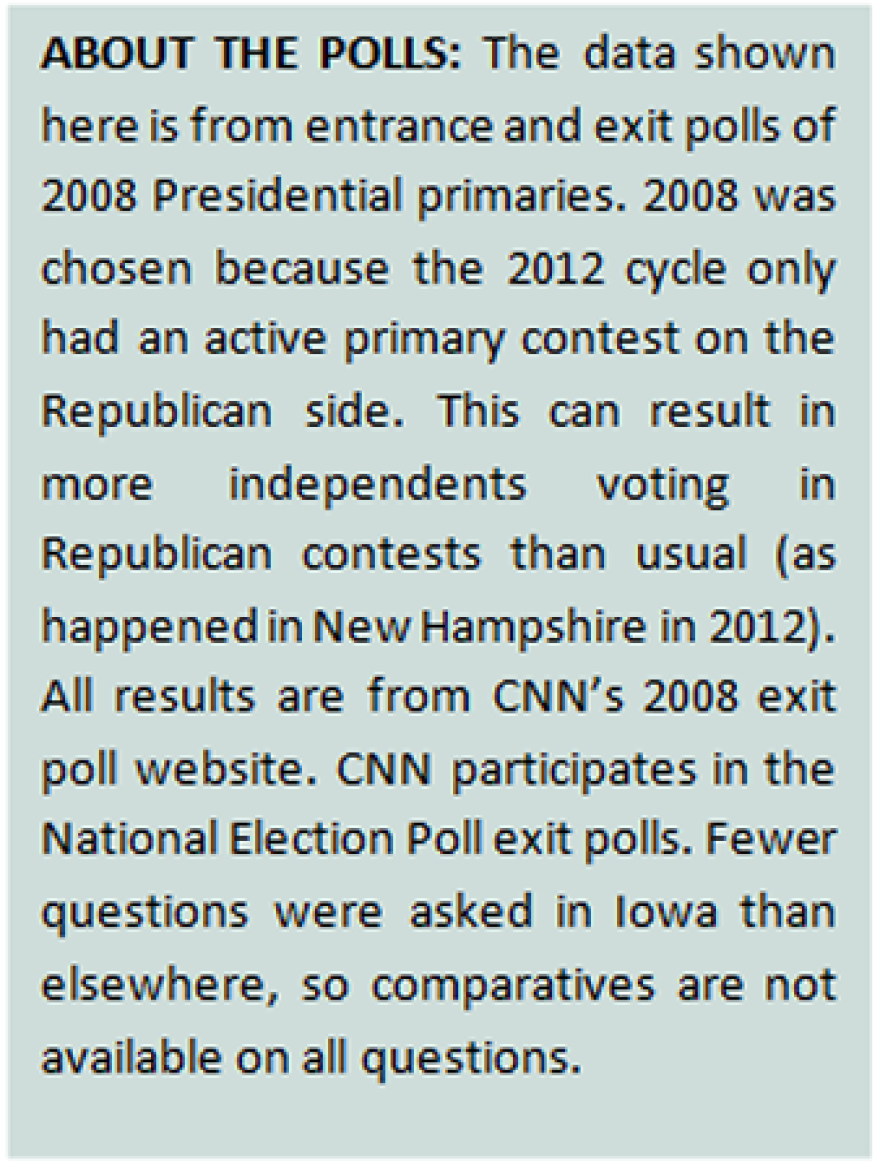Every four years or so, someone proposes replacing Iowa and New Hampshire as the first two states on the presidential nomination calendar, raising the hackles of activists and politicos in both states. This year the call is perhaps more newsworthy, since it came from Republican Party chairman Reince Priebus, in an interview with National Journal.
Rather than rehashing the pros and cons of dumping Iowa and New Hampshire, let’s consider what the results might be if such a change were made. If both states were relegated to somewhere in the middle of the batting order, how would the early primary electorate change? Since Priebus raised the issue, let’s focus first on the Republicans.

To answer this question, we compared the demographics of GOP primary voters from all 26 states where exit polls were conducted in the 2008 presidential primaries. The data show that, as a pair, Iowa and New Hampshire actually serve Republicans quite well as the first two states. This is because, between the two, they cover the spectrum of Republicans who participate in selecting the party nominee. Iowa anchors the conservative right, the evangelical, the older, the more rural. New Hampshire brings the moderate middle, suburban voters, and the less church-going. There’s even good economic coverage: Iowa voters are relatively lower income, New Hampshire are higher.
IA and N.H. offer good coverage of the spectrum of GOP primary states
Republicans who complain about the first two states often mention the rural, conservative, and heavily evangelical Iowa caucus participants.
Such voters, the thinking goes, force candidates to take extreme positions to earn their support, which make the candidates unpalatable to a less conservative general electorate.
Chart: % of Voters in Each GOP Presidential Primary Who Fit in Each Category (2008)


On this point, critics of Iowa as leadoff hitter have a legitimate beef. Fully 88 percent of Iowa GOP primary voters described themselves as conservatives, the highest of any state we have data on, by some distance. Iowa voters are also the most rural of any state; in 2008, 69 percent of GOP caucus-goers hailed from the state’s rural areas. And Iowans are among the most likely to say they are “born again” or “evangelical”.
If Iowa is too far to the right, then New Hampshire has the opposite problem when it comes to representing Republican primary voters. Its GOP primary voters, famous for giving moderate candidates a shot, are so far to the political center as to be barely clinging to the left edge of Republican political spectrum.
Only 55 percent of Granite State GOP voters described themselves as conservative, putting it on a par with traditionally blue states like New York and New Jersey. New Hampshire is also near the bottom of the pack in terms of church attendance and share of born again or Evangelical voters. And it is in the top ten in terms of income. All of which make the Granite State’s GOP primary a demographic outlier.
N.H. and IA: The left and right of Republican Primary voters
In other words, Iowa and New Hampshire are near mirror images of one another, at least when it comes to Republican politics. But taken together, they manage to cover the full breadth of the conservative political spectrum.
However, the two states do share one problem: neither looks anything like the national electorate when it comes to race. Thus, candidates have little incentive in Iowa or New Hampshire to take positions which might endear them to the more diverse national electorate.
Chart: % of 2008 GOP Primary voters calling themselves "conservative" in each state

But Republicans may actually have little to gain by putting other states first, since running primaries in more diverse areas doesn’t necessarily result in attracting more diverse voters. Republican primary voters are overwhelmingly white, even in later states with far more racially diverse populations. More will be needed to bring non-white voters into Republican primaries than simply changing the order of the states. California was the only state in 2008 where the percentage of GOP primary voters who were non-white dipped below 80 percent, and all but 5 states were 90 percent or more white.
Democrats, on the other hand, would actually have more reason to schedule their early primaries in other states, since the party’s primary electorate tends to much more diverse once the election moves past Iowa and New Hampshire.
Little diversity in Republican primaries
Ultimately, it’s up to each party to decide the goals of their primary calendar. If Republicans want more moderate nominees, they could move more states like New Hampshire to the front of the pack.
Chart: % of GOP Primary voters who were white

If the party wants candidates who represent the mainstream of the Republican spectrum, neither of the current two first-movers makes any sense. If they ignore ideology altogether, they could move to a truly random system, or rotate the order of primaries every four years, or hold a national primary.
All this is leaving aside the argument often offered by Iowa and New Hampshire boosters: that both states have a history of choosing, know their roles, take the process seriously, and give longshot candidates a chance to compete in a relatively inexpensive set of media markets.
But if you were to pick two states that together cover the totality of Republican primary voters, it’s hard to come up with a much better selection than the current odd couple.
Steve Koczela, president of The MassINC Polling Group, writes for NHPR about polling, voter demographics and other topics related to the 2016 New Hampshire presidential primary. Find Steve's other columns here. He tweets at @skoczela.







